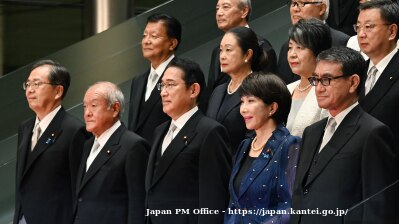Brazil could emerge as a major competitor to China in the strategically critical rare earths market amid escalating global trade tensions and surging demand for these essential elements in high-tech manufacturing, Bloomberg Linea reported.
Latin America’s powerhouse could leverage its position as the holder of the world's second-largest reserves, with approximately 21mn tonnes of rare earth reserves as of 2024, second only to China's 44mn tonnes, according to the US Geological Survey data cited by Statista.
This positions Brazil favorably in the global race to secure supply chains for these elements, which are vital components in technologies ranging from smartphones and electric vehicles to renewable energy systems and defence applications.
"Becoming a global supplier of raw materials — adding rare earths to the range of products already exported — is crucial for the Brazilian economy," said Francisco Américo Cassano, a professor and consultant, adding Brazil should aim to strengthen its position as "a global supplier of commodities and an importer” of products with higher added value.
Brazilian mining company Serra Verde Group is spearheading the country's push into this market from its base in Goiás state, aiming to deliver 5,000 tonnes of rare earth oxide annually by 2026. It projects demand for its products to increase by 8.5% annually through 2035.
This development comes as rare earths take centre stage in the escalating trade conflict between the US and China. Earlier this month, US President Donald Trump announced an investigation into potential tariffs on critical minerals, including rare earths, which his administration considers "building blocks of the defence industrial base."
The US currently imports approximately 70% of its rare earths from China, which controls about 61% of global production according to International Energy Agency (IEA) figures.
Market analyst Alexander Londoño of ActivTrades believes Latin America is "really just beginning to explore the potential of rare earths," noting that while the initial investment is substantial, "these are the materials that will be most used” in the future.
However, he cautioned that exploitation of these resources depends heavily on government policies and environmental considerations, as ecosystem disruption is a concern in extraction processes.
The increasing strategic importance of rare earth elements is reflected in their price outlook. Financial analyst Gregorio Gandini told Bloomberg that prices are expected to rise significantly over the coming years.
For example, lanthanum oxide, used in pharmaceutical applications and optical glass manufacturing, currently trades at approximately $550 per tonne on the Shanghai Metal Exchange but could reach $1,100 per tonne by 2030.
Brazil's rare earth potential has already attracted international investment. In January, Saudi mining company Ma'aden announced plans to invest approximately BRL8.0bn ($1.41bn) in Brazilian mineral exploration, according to Alexandre Silveira, Minister of Mines and Energy.
Meanwhile, the government is exploring alliances with Middle Eastern partners to optimise the processing of strategic minerals, including rare earths.
Despite these opportunities, the professor and consultant Cassano expressed concern that Brazil is not fully capitalising on its rare earth potential for domestic technological development.
He argued, for instance, that the country should focus more on training scientists capable of generating knowledge and technology for local applications rather than exporting intellectual talent to more advanced nations.
Beyond rare earths, Brazil is also a significant regional producer of other strategic elements vital to new technologies, including cobalt, lithium, manganese, and silicon.
While these are not classified as rare earths, they play crucial roles in emerging technologies, particularly in energy storage and electric mobility applications.
A report published by Diario do Comercio focused on the regions in Brazil rich in rare earths, which are widely distributed around its vast geography in a country where much more development is still needed.
The country's deposits of the 17 critical elements are strategically distributed across several Minas Gerais states, with the Araxá locality containing deposits of monazite, niobium and smaller amounts of other rare earths.
Bahia's Caetité locality focuses on yttrium and neodymium; Amazonas' Seis Lagos Province offers high potential despite environmental challenges; while Goiás and Pará also feature promising occurrences in alkaline rocks.
The report also highlighted how rare earths could deliver substantial economic benefits due to the higher prices compared with other materials Brazil currently exports – they cited materials like neodymium oxide, which currently trades at $75,000 per tonne, compared to just $120 per tonne for conventional iron ore.
As global demand for these critical minerals continues to grow amid technological advancement and energy transition efforts, Brazil's vast natural resources position it to potentially reshape global supply chains and strengthen its economic standing in global markets.
Earlier in May, Malaysia-headquartered Lynas Rare Earths, the world's largest rare earths producer outside China, said it was exploring potential acquisitions of deposits in its domestic market as well as Brazil as part of its growth strategy, according to CEO Amanda Lacaze.
News

Nigeria’s president approves $2.6bn bond to clear GenCos’ debts
President Bola Tinubu has approved a NGN4 trillion ($2.6bn) bond to settle long-standing debts owed to power producers and gas suppliers, aiming to inject liquidity into Nigeria’s electricity sector.
.jpeg)
Claudia Sheinbaum’s first year tests Mexico’s new direction
President Claudia Sheinbaum’s first year in office has been marked by a combination of political stability, expansive social policies and cautious diplomacy, all set against the backdrop of a slowing economy and growing institutional concentration.

Rifts on show at EU-Western Balkan summit in Albania
Differences apparent over EU reform as well as friction between Serbia and Kosovo.





